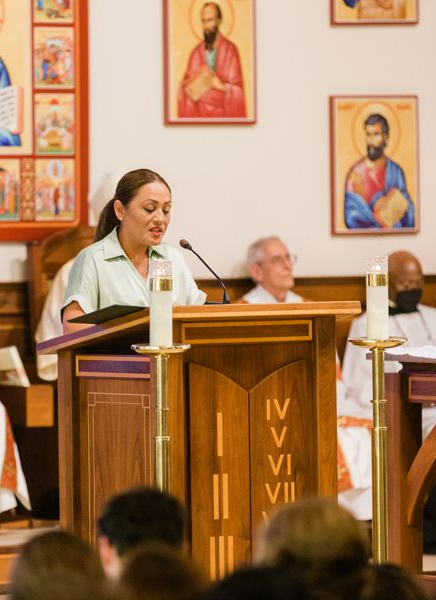Sacristans
What is a Sacristan?
The word “sacristy” means a place for sacred things. By the fifth century, ministers of the liturgy started designating a room for vessels and vestments, cloths and candles, books, and other appurtenances. It only make sense to store these items where they could be found and retrieved, and where they could be secured following the service.
The main sacristy was often pierced with doors giving access to the sanctuary, the nave and to the outside of the church. After the Council of Trent, sacristies became more elaborate. The Council recommended that the sacristan be a priest or a cleric, but this would eventually prove impractical. The role of the sacristan grew over a period of time.
Now we know the sacristan prepares the “things that are necessary” for the celebration of the Liturgy: the books, the vestments, the vessels, the bread, and the wine. But the sacristan’s does more that prepare the things needed for worship: the sacristan’s reverent, prayerful preparation can remind the entire assembly to prepare their hearts for worship.
Much of the sacristan’s time is spent “behind the scenes”, so to speak. Most often, the sacristan’s work is done before the liturgy begins. But this quiet, even invisible ministry is very important. After all, if the church door are not open, the assembly cannot gather. If the books are not ready, the word cannot be proclaimed. If the bread and wine are not prepared, the Mass cannot be celebrated. The work of the sacristan really matters.
Qualifications
Participants in the Ministry of Sacristans at St. John Vianney should have the following qualifications:
- Be scheduled regularly and be willing to serve when needed and as requested.
- Be fully initiated and practicing members of the Catholic Church.
- Be a registered member of the parish.
- Must be responsible, mature and reliable.
- Should be quick learners and very organized.
- Attend Mass regularly
- Have knowledge of the Order of the Mass.
- Show reverence for the sacredness of the Sacred Vessels and the Body and Blood of Christ by their manner, dress and decorum at liturgy.
- Be fully aware of the manner of preparation, distribution and disposition of the Body and Blood of Christ.
- Participate in the ongoing formation and training program.
Sacristan Resources
Check your ministry schedule with Ministry Scheduler Pro! Click here.
Are you ready to become a Sacristan at St. John Vianney? Please fill out an application HERE.
Sacristans' Dress Code:
Gentlemen: dress slacks and a polo style shirt, button down dress shirt, sweater or plain t-shirt with sleeves. Suit or coat with or without tie.
Ladies: slacks, dress, or skirt (the knee or longer), blouse, sweater or shirt with a modest neckline.
Please avoid: shorts, flip flops or slippers, very high heels as they are tripping hazard, tennis shoes, spaghetti strap or strapless tops, excessively tight clothing. Political buttons, wristbands, clothing etc. are not appropriate.
If you are still unsure of what is appropriate, ask yourself “Is my attire suitable for one who is …”
- Proclaiming God’s Word
- Distributing the Body/Blood of our Lord
- Greeting those who have come to receive the Word and Holy Communion
- Preparing the “things that are necessary” for the celebration of the Liturgy.




Do you have questions?
Ana is happy to help! As Mission and Evangelization Coordinator, she will guide you through the Altar Server process. From training to ministry schedules, she is the one to call with any questions or concerns. She looks forward to serving you.
Ana Aleman de Cortez
Mission and Evangelization



